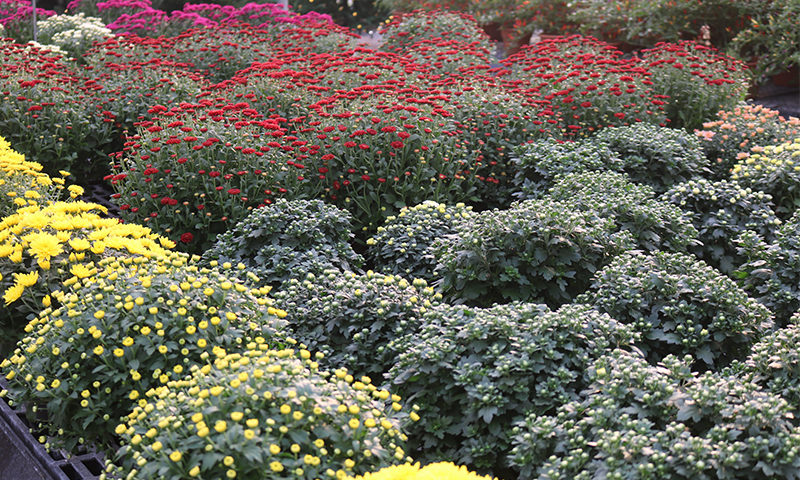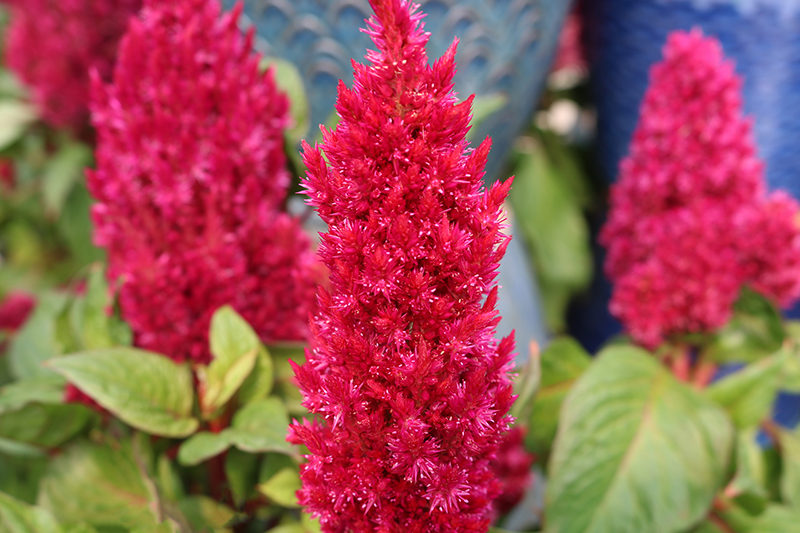Fall Gardener’s Calendar

Welcome Fall!
A new season means a whole new list of exciting projects to take on to maintain your garden. Specifically, Fall is a great time to add new life to your landscape, plus rehabilitate your lawn from Summer. It’s also a time to plant, fertilize, prune, and clean up. Overall, you can enjoy all the beauty that Fall brings when you take the right steps to improve your landscape.
So, what should be done when? Follow these quick suggestions for Fall gardening steps to success:
September Steps
Planting
Vacations are over. School just started. And, Fall is in the air! The temperatures will slowly start to drop and the foliage around your home will surely change. While Summer-blooming plants may be spent, now is the time to bring home Fall-blooming plants from our stores! Try sprucing up your perimeter with pansies, flowering ornamental cabbage and kale, and gorgeous flowers such as celosia, asters, and echinacea. Trees and shrubs make for excellent focal points and privacy screening plants, and their deep Fall foliage stuns. Everyone’s favorite Fall highlights, garden mums, also make their triumphant return.
Consider planting cool season veggies for great salad additions! Grow arugula, lettuce, radishes, spinach, broccoli, cabbage, carrots, and even garlic. If you don’t have the space in your garden, try a raised bed. This will actually help you during harvesting, as it’s less strenuous on your back to bend down and collect your homegrown produce!
Pick up your Spring-flowering bulbs from our Home & Garden stores and get excited for their future blooms. Pour love into them now and you’ll have a gorgeous garden when the cold temperatures are gone. From tulips, daffodils, and hyacinths, to snowdrops and more, we have everything you need to get started!
Testing and Treating
There are many miscellaneous tasks to cover over the course of September that revolve around repairing your landscape from Summer damage and taking precautionary measures against the potential harsh Winter conditions. Others involve simply tidying up or giving your plants a healthy boost! Follow the following advice to ensure your terrain continues to thrive:
- Spray Bonide All-Season Spray on hemlocks to control woolly adelgid, a small, aphid-like insect that terrorizes them.
- Test your lawn’s pH to check whether you need to apply lime this Fall. We provide FREE pH tests in store to help you understand your lawn’s status. A 50 lb. bag of lime will raise the pH by roughly half a point per 1000 square feet of turf.
- Aerate your lawn, re-seed and apply Fall lawn food. Keep your grass seed damp, watering every day if necessary. You should check for grubs, as they can wreak havoc with aeration. (An easy indicator to watch for is increased activity of skunks, raccoons, moles, and groundhogs.) Apply granular Sevin to control them.
- Clean out your water gardens and pools. Cover your pond with a netting before the leaves start to fall. See more info about Winterizing Your Pond.
Your houseplants need some Fall love, too! Treat them with systemic granules and insect-killing soap now to remove any threat of insects before bringing them into the house prior to the first frost.

October Steps
Next month still keeps you busy outdoors before temperatures really start to dip! In October, keep up with your plants with the following steps:
- Plant your Spring-flowering bulbs and fertilize with Espoma Bulb-Tone. Maintain a consistent watering schedule after planting.
- Divide your daylilies and Spring-blooming perennials, like iris and peonies.
- Avoid the temptation of pruning your Spring-flowering shrubs such as forsythia, azaleas, holly, lilac, rhododendron, spirea, or viburnum, as you will surely destroy next year’s buds
- Dig up your Summer-flowering bulbs, like dahlias, cannas, caladiums, and tuberous begonias after the frost kills the top growth. Treat them with Bulb Dust, pack them in peat moss, and store them in a ventilated area for the Winter.
- Fertilize your trees after the leaves fall. Fertilize azaleas, rhododendron, and evergreens with Holly-Tone and other shrubs with Plant-Tone.
- Spray hemlock again with Bonide All-Season Spray Oil.
- Spray evergreens, azaleas, rhododendron, boxwood, and rose canes with Wilt Pruf for protection against wind and cold weather.
- Clean up and destroy diseased rose leaves and debris surrounding shrubs and perennials. Mound 10-12 inches of dirt around roses to protect them from Winter damage. After the ground freezes, cover them with mulch.
- Remove annuals (roots and all) and add them to your compost pile.
- Cut back perennials unless they feature ornamental seed heads and fertilize with 5-10-5. Prune long raspberry and rose canes back to 3 feet high. Clean up your beds and gardens to avoid harboring insects and diseases over Winter.
- Pot hardy Spring bulbs and place them in a cold frame or cool garage.
- Or, sink them into the ground and mulch. Keep evenly moist.
- Water all plants well and mulch before Winter cold sets in!
Side Notes
- Rake leaves from the lawn consistently.
- Lower your mower blade.
- Check your compost pile.
- Set up bird feeders, clean up bird baths, refill and purchase heaters for the Winter.
Fall Lawn Care
Fall is the best time of the year to overseed your existing lawn or establish a new lawn. If your lawn is a bit thin, has bare patches, or needs good care, now is the time to take care of it so it can become thoroughly established before warm temperatures arrive in spring!
Overseeding A Weak Lawn
A weak lawn may have thin or scraggly patches, seem overrun with weeds, or have bare patches that are difficult to keep green and lush. Overseeding can help eliminate these problem areas and create a more consistent, luxurious lawn.
- Spray broadleaf weeds with a selective herbicide and wait 2 weeks for the weeds to disappear. Several treatments may be necessary if the yard is thick with weeds.
- Take a soil sample of your lawn. Visit us in-store for help with determining its pH level!
- Mow shorter than normal and rake clean to remove unnecessary debris that may keep seeds from reaching the soil.
- Core aerate if you have compacted soil or heavy thatch. Remove the cores and dispose of them properly to keep the soil light and airy for seeding.
- Apply starter fertilizer and lime if determined to be needed by the pH test, or choose a grass type that will thrive in your soil’s conditions.
- Dethatch your lawn if thatch is thicker than ½ inch. This can be done with heavy raking or a special dethatching rake may be necessary in extreme cases.
- Overseed with the proper seed. If core aerating, lightly dress with topsoil or humus.
- If needed, cover the freshly seeded area with netting to for watering purposes.
- We recommend for customers to cover there newly laid grass seed with a product specifically for grass seeding purposes. Tack Straw has no weed seed in it, and contains a bonding agent in it to prevent erosion. It’s also far less messy than straw!
- Water daily until grass has germinated, then soak once a week to encourage deep root growth.
- Fertilize in late fall with fall fertilizer.

Seeding A New Lawn
If you have no existing lawn or the entire ground is overrun with nothing but weeds, it may be best to start from scratch and create the lawn of your dreams.
- Kill existing vegetation with non-selective herbicide. If you want to preserve nearby trees or shrubs, take steps to protect that vegetation from the treatment.
- Take a soil sample of your lawn to determine the pH.
- Prepare soil by breaking up the surface with a rake or spade using a crisscross pattern.
- All large lumps should be broken up, and any large rocks should be removed.
- Broadcast starter fertilizer, lime, and gypsum as determined by the pH test. This will provide a nutrition boost for fresh seeds.
- Spread topsoil or humus to a ½ inch depth for appropriate planting.
- Rototill to a depth of 4 inches and grade smooth. This will mix all the top layers together for uniform soil and nutrition, ensuring even turf growth.
- Water daily until grass has germinated, then soak once a week to encourage deeper root growth to resist droughts and repel weeds.
- Fertilize in late Fall with Fall fertilizer to provide nutrition throughout the season.
Which Seed?
Not every lawn will thrive with the same type of grass seed. Allow our team to help you select the seed that best suits your needs, soil type, and planting conditions. Apply at the recommended rate and incorporate into the top ¼” of soil. Do not bury the seed or it may not germinate evenly.
No matter what the condition of your lawn, fall is the best time to take steps to help it rejuvenate so you have an amazing lawn to enjoy in spring.
Visit our Home & Garden Stores!
We understand Fall is a very busy time for most people! Whether you’re an expert gardener, or you’re starting from square one, we’re here to help make caring for your Fall landscape a breeze! We’ll recommend the best products and guide you through any process that you might need to keep your lawn and gardens thriving.
Talk to our team members today!
